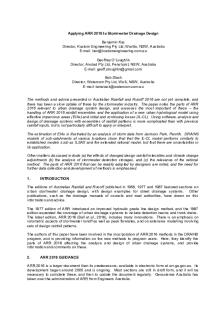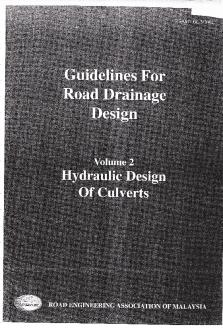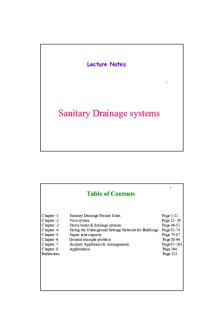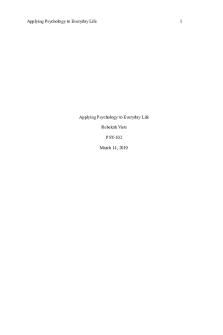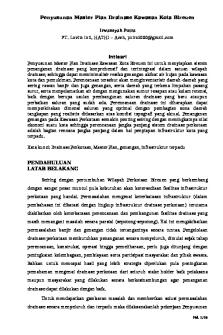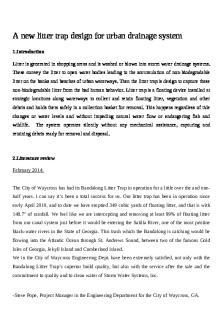Applying ARR 2016 to Stormwater Drainage Design PDF

| Title | Applying ARR 2016 to Stormwater Drainage Design |
|---|---|
| Course | Flood Estimation |
| Institution | University of Technology Sydney |
| Pages | 13 |
| File Size | 1 MB |
| File Type | |
| Total Downloads | 46 |
| Total Views | 164 |
Summary
Provides Summary of Major Parameters on stormwater drainage design and flood studies....
Description
Applying ARR 2016 to Stormwater Drainage Design Benjamin Kus Director, Kustom Engineering Pty Ltd, Warilla, NSW, Australia E-mail: [email protected] Geoffrey O’Loughlin Director, Anstad Pty Ltd, Penshurst, NSW, Australia E-mail: [email protected] Bob Stack Director, Watercom Pty Ltd, Wolli, NSW, Australia E-mail: [email protected]
The methods and advice presented in Australian Rainfall and Runoff 2016 are not yet complete, and there has been a slow uptake of these by the stormwater industry. The paper notes the parts of ARR 2016 relevant to urban drainage system design, and assesses the most important of these – the handling of ARR 2016 rainfall ensembles and the application of a new urban hydrological model using effective impervious areas (EIAs) and initial and continuing losses (IL-CL). Using software, analysis and design of drainage systems with ensembles of rainfall patterns is more complicated than with previous rainfall inputs, but is not particularly difficult to apply or interpret. The estimation of EIAs is illustrated by an analysis of storm data from Jamison Park, Penrith. DRAINS models of sub-catchments at various locations show that that the IL-CL model performs similarly to established models such as ILSAX and the extended rational model, but that there are uncertainties in its application. Other matters discussed include (a) the effects of changed design rainfall intensities and climate change adjustments (b) the analysis of stormwater detention storages, and (c) the relevance of the rational method. The parts of ARR 2016 that can be readily adopted by designers are noted, and the need for further data collection and development of methods is emphasised. 1.
INTRODUCTION
The editions of Australian Rainfall and Runoff published in 1958, 1977 and 1987 featured sections on urban stormwater drainage design, with design examples for street drainage systems. Other publications, such as the drainage manuals of councils and road authorities, have drawn on this information and advice. The 1977 edition of ARR introduced an improved hydraulic grade line design method, and the 1987 edition expanded the coverage of urban drainage systems to include detention basins and trunk drains. The latest edition, ARR 2016 (Ball et al., 2016), includes many innovations. There is an emphasis on volumetric aspects of stormwater runoff as well as peak flowrates, and on extensive modelling involving sets of design rainfall patterns. The authors of this paper have been involved in the incorporation of ARR 2016 methods in the DRAINS program, and in providing information on the new methods to program users. Here, they identify the parts of ARR 2016 affecting the analysis and design of urban drainage systems, and provide information and comments on these. 2.
ARR 2016 GUIDANCE
ARR 2016 is a larger document than its predecessors, available in electronic form at arr.ga.gov.au. Its development began around 2005 and is ongoing. Most sections are still in draft form, and it will be necessary to complete these, and then to update the document regularly. Geoscience Australia has taken over the administration of ARR from Engineers Australia.
Applying ARR 2016 to Stormwater Drainage Design
Kus
Book 9, dealing with urban stormwater, appeared as a rough draft in 2015, which was replaced when ARR 2016 was released in late 2016. Chapter 6 of Book 9 was released for comment in January 2018. The book provides a significant amount of guidance, emphasizing an approach oriented to the control of volumes of stormwater, as well as peak flowrates. It also encourages integrated water management, where three main objectives – flood protection, stormwater pollution control and water harvesting, are considered, and stormwater drainage systems are integrated with water supply, sewerage and waterway management systems. The information and guidance supplied is rational, and should, in the main, be accepted by drainage authorities and professionals. A problem is that most of the advice is at high- and medium-levels, and there is insufficient material about the practical application of principles and procedures. The only example in Book 9 is a case study of urban flood modelling. It appears that designers must refer to other publications for detailed guidance. The ARR Team has not specified software products or models until the release of Chapter 6 in Book 9, which recommends appropriate models for different scales and types of development. The material in the following sections shows that sets of input data and methods from ARR 2016 can be applied in stormwater system design, but there are incomplete parts that make it impracticable to apply some recommended methods fully. 3.
HYDROLOGY
3.1.
Rainfall Inputs
The Bureau of Meteorology (BOM) has almost completed the significant task of revising and extending intensity-frequency-duration (I-F-D) data that provides design rainfall estimates for a range of frequencies and durations, at all locations in Australia. I-F-D data are easily obtained from the Bureau’s website (www.bom.gov.au/water/designRainfalls/revised-ifd/?year=2016). The team responsible for producing Australian Rainfall and Runoff has developed sets of temporal rainfall patterns to be used in conjunction with I-F-D data to provide rainfall hyetographs as design inputs. The patterns are supplied in ensembles of ten different hyetographs for each storm duration, in rare, intermediate and frequent frequency groups. This information can be obtained easily from the ARR Data Hub (data.arrsoftware.org/). The background to these data is set out in Chapters 3 and 6 of Book 2 of ARR 2016. The I-F-D data have been developed from a much larger set of recorded rainfalls than the previous 1987 relationships, using superior statistical analysis techniques. They cover a wider range of frequencies and storm durations than the previous relationships. The temporal patterns have also been derived from a large database of storm data. They are bursts of rainfall, often extracted from longer storms, rather than complete storms. The ARR 2016 I-F-D relationships can be used in relatively simple rational method calculations, estimating peak flowrates. In models that produce flow hydrographs, the I-F-D and ensemble data must be combined. Use of the ensembles considerably increases the numbers of cases to be considered, and makes the use of software compulsory, since the volume of calculations is too great for hand or spreadsheet calculations. In DRAINS, ensembles are inputted from the .csv files provided on the BOM website and the ARR Data Hub, and the required frequencies and storm durations are selected for design. The program performs design calculations that define pit and pipe sizes and analyses that simulate the behaviour of drainage systems in major or minor events. After an analysis run, all components (pits, pipes, detention basins, etc.) can be interrogated to display the results for each storm in charts like those in Figure 1. These display ten results for all storm durations modelled, except 5 minutes. For each duration a median storm is selected, shown pink, and from these the highest is selected as the design value, shown red. The design storms can differ for the various components in a model, depending on the type of component and its location in a catchment. Generally, the critical duration will increase as flows move downstream through a system. The chart outputs give a good overview of how the various parts of a drainage system operate. Extremes are shown, but designs work on the basis of the median storms. Individual storms can be modelled in detail if required.
Stormwater 2018 – Kus, O’Loughlin and Stack (October 2018)
2 of 13
Applying ARR 2016 to Stormwater Drainage Design
Kus
Figure 1 DRAINS Chart Outputs for Sub-Catchment (Top) and a Detention Basin (Bottom) This process has been found to be easy to apply, and calculations in DRAINS have been streamlined to operate quickly, facilitating trial and error calculations. A designer has additional work to do, compared to running storms from ARR 1987, but the design process works smoothly. The BOM has compared 1987 and 2016 rainfall intensities in the FAQ information on its website. At the majority of locations, intensities will be smaller, but at some locations, such as Newcastle, designers must cope with higher rainfall intensities. Drainage authorities and designers must also consider the climate change adjustments to design rainfalls covered in Book 1 of ARR 2016. The adjustment is specified in the equation: Ip = IARR × 1.05Tm
(1)
where Ip is the projected rainfall intensity or equivalent depth (mm/h or mm), IARR is the rainfall intensity or depth for current conditions (mm/h or mm), and Tm is the expected temperature increase at a selected time in the future (ºC). For each 1º C rise in temperature, rainfalls are increased by approximately 5%. Designers must decide on an appropriate climate change scenario, based on a judgement of the extent to which climate change can be arrested, and then to assess whether adjustments should be applied. An assessment procedure is presented in Section 6.3 of Book 1. Stormwater 2018 – Kus, O’Loughlin and Stack (October 2018)
3 of 13
Applying ARR 2016 to Stormwater Drainage Design
3.2.
Kus
Recommended Urban Hydrological Models
ARR 2016 provides considerable material on hydrological modelling, largely geared to rural and urban flood studies and large catchments. The most important section for urban drainage systems is Chapter 3 in Book 5, dealing with hydrological losses. For urban areas, Chapter 3 applies the concept of effective impervious area (EIA), representative of the area within a catchment that generates a rapid runoff response in rainfall events. The EIA includes part of the impervious area directly connected to the drainage system (DCIA). The remaining part of the catchment area lumps together the rest of the DCIA, the indirectly-connected impervious area (ICIA) which discharges onto pervious surfaces, and pervious areas. This division of urban catchments into two parts – EIA and ‘other’ or ‘remaining’ , is applied in Section 3.5 of Book 5, together with the application of a loss model. The preferred model is an initial loss – constant continuing loss (IL-CL) model. Other models were considered, and can still be used, including the proportional continuing loss and Horton infiltration models, but the IL-CL model was adopted as being equally or more effective and simpler. Some specifications for applying this model are presented in Table 1. Table 1 Details of the EIA IL-CL Model Part of Sub-Catchment
Loss Parameters
Effective impervious Area (EIA) made up of part of the DCIA and perhaps some of the ICIA. EIA is 50% to 70% of the TIA (ARR 2016, Section 3.4.2.2.2), or 60 to 80% of the DCIA.
1 - 2 mm initial loss (IL), zero constant continuing loss (CL) (Section 3.5.3.2.1 of ARR 2016)
Indirectly Connected Areas (also known as other or remaining areas), made up of some DCIA, the ICIA and pervious areas that interact with impervious areas.
IL is 60% to 80% of the rural IL for the location (Section 3.5.3.2.1) with some qualifications; CL is 1 - 4 mm/h, with a typical value of 2.5 mm/h for South Eastern Australia. For some state or territory capitals, losses could be determined from Figures 5.3.21 and 5.3.22. (The ARR Data Hub cautions against using rural loss estimates in urban areas, conflicting with Section 3.5.3.2.1.).
Urban Pervious Areas (large, self-contained areas such as parks or bushland).
IL and CL are to be the same as for a rural area at the same location (Section 3.5.3.2.3).
The application of the EIA is new, and it has not been featured in any of the hydrological models previously applied to urban drainage systems. Earlier models use total impervious area (TIA) in the rational method and RORB, for example, and DCIA, in MUSIC. The ILSAX hydrological model in DRAINS considers DCIA (termed paved) and ICIA (supplementary) impervious areas. EIA cuts across the previously-used categories, and is hard to define. The recommended EIA percentage for a catchment is about 60% of the TIA, or 70% of the DCIA determined from aerial imagery, based on an analysis of rainfalls and runoff from eight urban gauged catchments that produced the ratios shown in the first eight rows of Table 2. This analysis was explained in the ARR revision project report by Phillips et al (2014). It entailed the estimation of the volumes of storms and runoff hydrographs at the selected stations, and the plotting of these to obtain an assumed ratio between the EIA and the TIA. Events that only produced runoff from the EIA were assumed to be the storms for which: Q < TIA/TA × (P – IL)
(2)
where Q is the runoff depth (mm), P is the rainfall depth (mm), TIA and TA are defined from a GIS or map analysis and IL is the initial loss on impervious surfaces (typically 1 mm). The criterion does not necessarily separate large and small storms; and large storms appear in both EIA Runoff Only and EIA + Other Runoff categories.
Stormwater 2018 – Kus, O’Loughlin and Stack (October 2018)
4 of 13
Applying ARR 2016 to Stormwater Drainage Design
Kus
Table 2 Results of Urban Gauged Catchment Analyses
Albany Drain , WA McArthur Park, NT Giralang, ACT Parra Hills Drain, SA Kinkora Road, Vic Powells Creek, NSW Ithica Creek, Qld Argyle Street, Tas
Total Area, TA (ha) 8.2 144 91 55.1 202 232 926 1900
Total Impervious Area, TIA (ha) 2.9 53.7 28.4 26.9 122 152 128 292
Jamison Park, NSW
23.4
8.34
Catchment
0.35 0.37 0.31 0.49 0.60 0.66 0.14 0.15
DCIA/TIA (from GIS or maps) 0.83 0.93 0.95 0.87 0.87 0.81 0.95 0.93
Assumed EIA/TA Ratio from Plots 0.21 0.24 0.25 0.27 0.35 0.38 0.075 0.091
EIA/TIA = EIA/TA / TIA/TA 0.59 0.66 0.79 0.56 0.59 0.59 0.55 0.63
EIA/DCIA = EIA/TIA / DCIA/TIA 71 70 82 64 68 75 58 68
0.36
0.93
0.235
0.65
0.70
TIA/TA
To understand the process, the analysis has been performed using storm data collected from 1984 to 1988 at a gauged catchment at Penrith, NSW operated by the University of Technology, Sydney and Penrith City Council. The results are shown in the last row of Table 2. The EIA/TA ratio was obtained from the slope of the line fitted to the blue points (diamonds) in Figure 2, assumed to be for storms where runoff comes from the EIA only. The slope of this line (0.235) can be divided by the TIA/TA ratio (0.36) to give the EIA/TA ratio of 0.65, which can also be transformed into an EIA/DCIA ratio of 0.70 by dividing by DCIA/TIA (0.93). The answers are sensitive to the slope of the line fitted to the EIA Only Runoff values.
Figure 2 Rainfall & Runoff Volumes of 1984-88 Storms at Jamison Park Gauge, Penrith In the storms considered, the volumes of runoff are less than those of the corrresponding rainfalls, showing that losses are occurring. The EIA concept is based on the observation that the losses from the DCIA are greater than we would expect from an impervious area connected to the drainage system. The reasons for this deficit are unclear and few explanations are supplied in ARR 2016. Possible causes of this missing runoff are infiltration into soils, stormwater flows into sanitary sewers (perhaps 5% to 15% of the volume), retention in depression storages and temporary ponds against walls and fences on properties. Stormwater 2018 – Kus, O’Loughlin and Stack (October 2018)
5 of 13
Applying ARR 2016 to Stormwater Drainage Design
Kus
The analysis is entirely based on volumes of rainfalls and runoff (depths × catchment area), and peak flowrates have not been considered. To estimate runoff, the loss model must be combined with a routing model, and ARR 2016 offers two choices for this – time-area routing or runoff routing using conceptual storages, applied in models such as RORB, XPRAFTS, WBNM and URBS. There is little new material in ARR 2016 on hydrological routing, or on the important topic of urbanisation, related to the comparison of pre- and post-developed runoff peaks and volumes in land, property and infrastructure development applications. 3.3.
Difficulties with the IL-CL Model
Two problems have been identified while attempting to apply the recommended urban EIA IL-CL model in DRAINS: (a) The recommended EIA/TIA and EIA/DCIA ratios are typically 60% and 70%. These may be plausible for larger sub-catchments involving buildings, paved open areas and gardens, with some footpaths and streets. However, they seem to be too low to apply to small sub-catchments and to catchments on roads where runoff processes are direct, particularly in new drainage systems, and it is difficult to see where runoff could be lost. In the authors’ own modelling practice with DRAINS, an EIA/TIA ratio of 90% to 100% has been applied in smaller sub-catchments. Book 9 of ARR 2016 gives some guidance in Section 6.2.1 (Coombes et al., 2018), suggesting that ratios should be higher in more densely-developed sub-catchments. Designers will need to make their own decisions. Swan et al (2018) describe a system for determining EIA/TIA ratios for different land uses, developed for Melbourne Water flood mapping, and Gribble (2017) has estimated DCIA values for Western Sydney. (b) As shown in Figure 3, rainfall hyetographs can be separated into various components. The rainfall patterns supplied by the ARR Data Hub are bursts. Usually, it will be necessary to subtract a preburst rainfall estimate from an initial loss to determine the burst initial loss IL B to be applied to ensemble patterns. The ARR team have emphasised the importance of using pre-burst depths. However, pre-burst estimates are only available from the ARR Data Hub for storms with durations of 1 hour or greater. This makes it difficult to apply the ARR 2016 preferred model on urban catchments, where storms with durations below 1 hour usually produce the most critical results. Users must guess pre-burst values. There are other complexities with pre-burst adjustments, and these throw into doubt the applicability of the recommended procedure.
Figure 3 Distinction between Storm and Burst Initial Loss (Figure 5.3.5, ARR 2016) Another problem is that peak flowrates from the IL-CL model can show little change as EIA increases if the remaining area times of concentration are not decreased. The combined EIA and remaining area hydrographs provide only small increases in peak flowrates, making it difficult to compare pre- and postdeveloped catchment results. Like other hydrological models, the IL-CL model has faults that need to be managed when it is applied. It cannot be improved without further testing using available urban catchment data, which is limited, and is not easily accessible to designers. Stormwater 2018 – Kus, O’Loughlin and Stack (October 2018)
6 of 13
Applying ARR 2016 to Stormwater Drainage Design
4.
Kus
COMPARISON OF RESULTS FROM ALTERNATIVE MODELS
To test the EIA IL-CL model against commonly-used models for urban drainage design (ILSAX, rational method and extended rational method (ERM)), a series of simple 0.25 ha catchment models have been created in DRAINS for impervious area percentages between 5% and 95%, as shown in Figure 4. These have been run for 1% annual exceedance probability (AEP) and 0.2 EY (5 year average recurrence interval) frequency storm ensembles for durations of 5 minutes to 4.5 hours. The times of concentration applied in all models is 5 minutes for impervious areas and a diminishing time of 15 minutes down to 5 minutes for pervious areas as the percentage ...
Similar Free PDFs
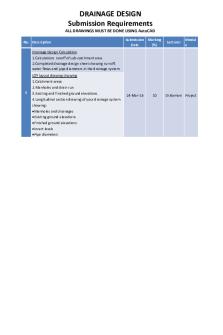
Drainage Design
- 43 Pages

URBAN DRAINAGE DESIGN MANUAL
- 478 Pages
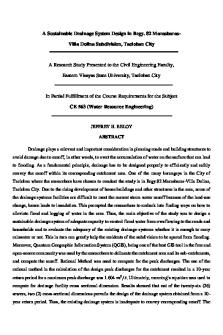
DRAINAGE SYSTEMS DESIGN
- 22 Pages
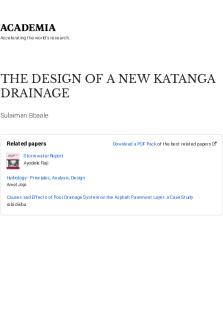
THE DESIGN OF A NEW KATANGA DRAINAGE
- 106 Pages

Drainage
- 7 Pages

Physics SD-2016 - Study Design
- 49 Pages
Popular Institutions
- Tinajero National High School - Annex
- Politeknik Caltex Riau
- Yokohama City University
- SGT University
- University of Al-Qadisiyah
- Divine Word College of Vigan
- Techniek College Rotterdam
- Universidade de Santiago
- Universiti Teknologi MARA Cawangan Johor Kampus Pasir Gudang
- Poltekkes Kemenkes Yogyakarta
- Baguio City National High School
- Colegio san marcos
- preparatoria uno
- Centro de Bachillerato Tecnológico Industrial y de Servicios No. 107
- Dalian Maritime University
- Quang Trung Secondary School
- Colegio Tecnológico en Informática
- Corporación Regional de Educación Superior
- Grupo CEDVA
- Dar Al Uloom University
- Centro de Estudios Preuniversitarios de la Universidad Nacional de Ingeniería
- 上智大学
- Aakash International School, Nuna Majara
- San Felipe Neri Catholic School
- Kang Chiao International School - New Taipei City
- Misamis Occidental National High School
- Institución Educativa Escuela Normal Juan Ladrilleros
- Kolehiyo ng Pantukan
- Batanes State College
- Instituto Continental
- Sekolah Menengah Kejuruan Kesehatan Kaltara (Tarakan)
- Colegio de La Inmaculada Concepcion - Cebu
